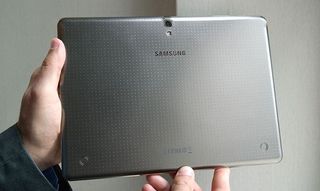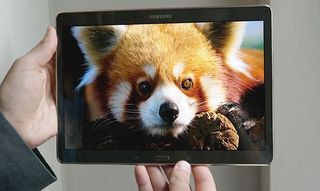Samsung Galaxy Tab S: iPad-Beating Screens, Tricky Accessories
Samsung knows that people love to watch video on their tablets, so it only makes sense that the company take one of the best parts of its Galaxy S5 phone--the rich AMOLED display--and supersize it for the new Galaxy Tab S. Coming in July in 8.4-inch ($399) and 10.5-inch ($499) sizes, both new tablets beat the iPad Air and iPad mini Retina when it comes to contrast, color and resolution. Plus, you can take calls and interact with your Galaxy S phone right from the larger display.
We went hands-on with the new Tab S slates just prior to their debut, and we’re loving the luscious screens, thin designs and family sharing features. But the accessories were a little trickier to use than we’d like.
Design: Thinner Than Air
If you’re looking for metal, you’ve still come to the wrong place, but Samsung deserves credit for delivering designs that feel modern and warm at the same time. Sporting clean lines, the Tab S comes in Dazzling White and Titanium Bronze, and they sport a dotted pattern on the back that’s similar to the Galaxy S5.
MORE: 15 Best Android Apps You're Not Using

As with the S5, you’ll also find a fingerprint sensor in the Home button for unlocking your device and making payments via PayPal. However, there’s a key design difference between the Tab S and S5. The tablet’s back cover houses two dimples that connect to Samsung’s new covers, which snap into place.

The new Tab S devices are also strikingly thin, measuring just 0.26 inche, compared to 0.29 inches for the iPad Air and mini. The 8.4-inch Tab S weighs 13.9 ounces, while the 10.5 inch model weighs 1.02 pounds. The aluminum clad 7.9 inch Retina Mini and 9.7-inch Air weigh a lighter 11.7 ounces and 1 pound, respectively, but they have smaller screens.
Awesome AMOLED Display
Samsung says that the 2560 x 1600-pixel AMOLED display on the Tab S has a 100 times better contrast ratio than other tablets with LCD screens, and we believe them. A nature video that showed a gorilla, fox and other animals looked as good as the real thing--actually better. The latest iPads look a little cloudier in dark scenes, and the resolution is a lower 2048 x 1536 pixels.
Stay in the know with Laptop Mag
Get our in-depth reviews, helpful tips, great deals, and the biggest news stories delivered to your inbox.
MORE: Top iPad Alternatives

As with the Galaxy S5 and Note 3 phones, AMOLED delivers brighter whites and darker blacks, as well as superior viewing angles. Plus, Samsung’s Adaptive Display tech automatically optimizes the color range, saturation and sharpness based on the lighting conditions. During our demo, we watched as a webpage’s look adjusted in real time as a company rep adjusted the lighting.
To help you get the most out of this screen, Samsung is partnering with Conde Nast and others for magazine and Marvel comics for a free trial.
SideSync 3.0: Control Your Phone
Easily the coolest feature of the Tab S, SideSync 3.0 lets you interact with your Galaxy smartphone right on the big screen. Connecting via Wi-Fi Direct, you can drag and drop photos, launch apps, and take calls through the tablet. We had no problem answering a call through the Tab S and gabbing away using its built-in speaker. The SideSync app did lag at times, but we’re hoping that’s due to so many devices being in the room at once.

Family Sharing Done Right
It’s nice to see that Apple will finally make the iPad more family friendly this fall with Family Sharing in iOS 8, which will let you share purchases, calendar, location and more. But there still isn’t a dedicated mode for children. Samsung brings that to the table with Kids Mode, which gives junior a walled garden populated only with apps you approve. You can even have Junior log in directly with his fingerprint.
MORE: Kids Tablets to Buy (or Avoid)
Other Specs and Features
Just as we’d expect from a Galaxy Tab running TouchWiz (on top of Android 4.4 KitKat), the Tab S lets you run two apps on the screen at once using the Multi Window feature. An octa-core Exynos processor and 3GB of RAM should keep things running smoothly on both tablets, although we noticed a delay when switching screen orientations.

You’ll find an 8-MP camera on the back and a 2.1-MP camera up front for selfies. The Tab S will come with 16GB of storage standard, which you can upgrade via the microSD Card slot. An LTE version will also be available, but Samsung has not yet announced pricing or carrier availability.
Accessories: Versatile, But Awkward
We definitely wouldn’t call Samsung’s Simple Cover and Book Covers smart. Available in six fetching colors, these accessories attach to the back of the Tab S via an awkward snapping mechanism. We found removing the covers fairly difficult, as it takes a lot of force to rip them off. Of the two options, the Book Cover is more flexible, allowing you to use it in multiple modes. However, switching from one mode to another isn’t intuitive.

The Bluetooth keyboard shares the titanium bronze cover of the Galaxy Tab S. The layout is on the cramped side, but the keys offered plenty of travel as we typed. The jewel-like lock on the front helps keep the keyboard secure when you want to carry the device around like a clamshell.

Outlook
You really have to see the Galaxy Tab S tablets in person to appreciate just how awesome their AMOLED screens are. Whether you opt for 8.4 inches or 10.5 (we prefer the latter), the displays make everything from movies and webpages to photos and games look bolder and richer than the iPad. We’re also glad that Samsung decided to migrate its SideSync software from PCs to tablets, making it easy to take calls from you slate as well as remotely control your Samsung phone.
However, Samsung’s biggest enemy isn’t necessarily the Apple iPad, but consumers’ waning interest in tablets. As phone screens get bigger, some shoppers are deciding to press pause on their slate purchases. We’ll have to see if the Tab S’ combination of eye candy, features and add-ons can shake things up.

Most Popular

